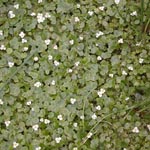European Frog-Bit
 Hydrocharis morsus-ranae
Hydrocharis morsus-ranae
European Frog-bit is a free-floating aquatic plant that resembles a miniature water lily. Originally from Europe and Asia, it was first introduced as a horticultural species to the Ottawa region in 1938 and then spread to the nearby Rideau Canal and Brown's inlet.
Characteristics
European Frog-bit belongs to the family Hydrochariticeae (Frog-bit Family) and looks similar to American Frog-bit (Limnobium spongia). It has a single white flower approximately 1.5 cm (.6 in) in diameter with three rounded petals and a yellow centre. The leaves of the plant are round, and heart shaped, (the size of a Canadian two-dollar coin) with veins coming off the mid-vein that arch broadly following the shape of the leaf. The undersides of the leaves are dark purplish-red and have a spongy coating, which helps the plant float on top of the water. Roots can range from 10-20 cm (3.9 - 7.9 in) but do not penetrate or anchor this free-floating plant to the bottom. Stolons, or runners originating from the centre of the plant, produce juvenile plants, which become entwined together or with other vegetation to form dense mats in the water.
European Frog-bit grows most abundantly in calcium-rich water and prefers wetlands, backwaters and quiet bays where there is limited wave action. It can reproduce both sexually and asexually with the latter being the most significant method European Frog-bit becomes established. With this method winter buds called turions are produced on the stolons. These turions break away and fall to the bottom before winter where they lie dormant and float to the surface in the spring and begin to grow seedlings. It has been estimated that a single plant can produce up to 100-150 turions.
Impact
European Frog-bit can have a negative impact on wetland ecosystems. Once established, Frog-bit can form very dense, impenetrable mats of floating vegetation, that prevent sunlight from reaching the submersed aquatic plants below. The poor growth conditions created by Frog-bit can affect the survival of indigenous plants. These thick mats can also impede the movement of large fish and diving ducks.
In the fall, European Frog-bit breaks apart and decomposes, falling to the bottom of the lake. The decomposition of huge volumes of vegetation in the water can deplete dissolved oxygen levels. If there are insufficient amounts of oxygen, fish and other aquatic organisms can die.
This invasive plant can also affect recreational uses such as boating and swimming. Frog-bit creates such a tangled network of vegetation that it can restrict these activities.
Prevention
Presently, there are few ways to control Frogbit. Removal by hand has been only a temporary solution. These plants can be spread to new waterbodies caught on propellers and other aquatic equipment. European Frog-bit is one of the many exotic species of aquatic plants that are sold in the water garden trade. If you have a water garden, it is always a good idea to buy native aquatic plants to prevent an accidental release. If you do buy exotics, over-winter your plants indoors or dispose of them in the garbage at the end of the season.
This information courtesy of Invadingspecies.com - Ontario Federation of Anglers & Hunters
Â
European Frog-bit ISCM Fact Sheet
Â
Back to Aquatic Invasive Species List
Â
© Copyright 2004-2025 - CMS Made Simple
This site is powered by CMS Made Simple version 1.4.1


